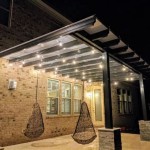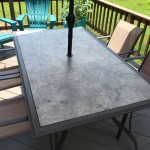DIY Patio Furniture Plans: Crafting Your Outdoor Oasis
Creating an inviting and comfortable outdoor living space significantly enhances the enjoyment of a home. Patio furniture plays a crucial role in transforming a simple outdoor area into a relaxing retreat for dining, entertaining, or simply unwinding. While commercially manufactured patio furniture offers convenience, undertaking do-it-yourself (DIY) projects provides an opportunity to customize pieces to specific needs, aesthetic preferences, and budgetary constraints. Exploring DIY patio furniture plans allows homeowners to express their creativity while constructing durable and personalized outdoor furnishings.
Selecting the appropriate materials constitutes a foundational step in any DIY patio furniture project. The choice of material impacts the furniture's longevity, weatherproof properties, aesthetic appeal, and overall cost. Common materials include wood, metal, and recycled plastics. Each material presents distinct advantages and considerations for construction and maintenance.
Wood, a classic choice for outdoor furniture, offers a warm and natural aesthetic. Varieties like cedar, redwood, and teak possess inherent resistance to decay and insect infestation, making them suitable for outdoor environments. Pressure-treated lumber provides an economical alternative, albeit requiring careful handling due to the chemical treatments involved. Working with wood necessitates basic carpentry skills, including cutting, sanding, and joining techniques. Proper sealing and staining or painting are essential to protect the wood from moisture and UV damage, extending its lifespan and preserving its appearance.
Metal, such as steel, aluminum, and wrought iron, delivers durability and structural strength. Steel offers robust support but requires powder coating or painting to prevent rust. Aluminum resists corrosion naturally, making it ideal for coastal environments. Wrought iron lends a classic and elegant touch but is heavier and more susceptible to rust if not properly maintained. Metalworking generally demands specialized tools and skills, including welding, cutting, and shaping. Adequate surface preparation and protective coatings are imperative to safeguard against weathering and corrosion.
Recycled plastics present an environmentally conscious option for patio furniture. These materials are typically weather-resistant, low-maintenance, and available in a range of colors and textures. Recycled plastic lumber resembles wood but does not rot, splinter, or require painting. Working with recycled plastics involves cutting, drilling, and fastening techniques similar to those used with wood. However, it is crucial to select high-quality recycled plastic that is UV-stabilized to prevent fading and degradation over time.
Key Considerations Before Embarking on a DIY Patio Furniture Project
Before commencing any DIY patio furniture project, meticulous planning is paramount. This involves assessing the intended use of the furniture, the available space, and the desired style. Defining these parameters ensures that end product meets practical needs and complements the existing outdoor environment. Selecting the appropriate plan, materials, and tools directly contributes to a successful and satisfying project.
Firstly, determine the specific types of furniture needed. Consider whether the project aims to create a dining set, a lounge area, or individual seating options. Estimate the number of chairs, tables, and other accessories required to accommodate the anticipated number of users. Assess the dimensions of the patio or outdoor area to ensure that the furniture fits comfortably without overcrowding the space. Measure the available space accurately and create a scaled layout to visualize the furniture arrangement.
Secondly, establish a budget for the project. DIY projects can be cost-effective, but it is crucial to factor in the cost of materials, tools, and any potential professional assistance. Research the prices of different materials and compare quotes from various suppliers. Consider renting or borrowing specialized tools if they are not already owned. Allow for contingency funds to cover unexpected expenses or material waste. Creating a detailed budget helps to stay within financial constraints and avoid overspending.
Thirdly, evaluate personal skill level and available time. DIY projects range in complexity from simple to advanced. Choose plans that align with existing carpentry or metalworking skills. If unfamiliar with certain techniques, consider taking a workshop or consulting with experienced DIYers. Estimate the time required to complete the project and allocate sufficient time in the schedule. Rushing through the project can lead to errors and a less satisfactory outcome. Break down the project into manageable steps and set realistic deadlines for each phase.
Popular DIY Patio Furniture Plans
Numerous DIY patio furniture plans cater to different skill levels and aesthetic preferences. Simple projects, such as building Adirondack chairs from pre-cut lumber or constructing a pallet coffee table, are suitable for beginners. More advanced projects, like crafting a sectional sofa frame or welding a metal bistro set, require greater expertise and specialized equipment. Exploring available plans online, in books, and through DIY communities provides ample inspiration and guidance. The following examples illustrate some popular options.
Adirondack chairs represent a classic and comfortable seating choice for patios, decks, and gardens. Plans for Adirondack chairs typically involve cutting and assembling wooden boards to form the characteristic sloping seat, high back, and wide armrests. Pre-cut lumber kits simplify the construction process for beginners, while downloadable plans offer detailed instructions and templates for those who prefer to cut their own lumber. Consider using cedar or redwood for enhanced durability and weather resistance. Finishing the chairs with a weather-resistant stain or paint protects the wood and adds a personal touch.
Pallet furniture offers an affordable and eco-friendly option for creating rustic-chic patio furnishings. Pallets can be repurposed into a variety of items, including coffee tables, sofas, and benches. To build a pallet coffee table, start by sanding the pallets to remove splinters and rough edges. Reinforce the structure with screws or nails if needed. Add legs or casters to raise the table to the desired height. Finish the table with a stain, paint, or sealant to protect the wood and enhance its appearance. Pallet furniture adds a unique and characterful element to outdoor spaces.
Concrete block benches provide a simple and contemporary seating solution for patios and gardens. These benches are easy to construct and require minimal tools and materials. The basic design involves arranging concrete blocks to form the base and adding wooden planks or cushions for seating. Concrete blocks are readily available at hardware stores and come in various sizes and colors. Wooden planks can be obtained from lumberyards or reclaimed from other sources. The blocks are stacked to create the desired height and length of the bench, and the wooden planks are secured on top. Customize the bench with paint, stain, or decorative elements to match the outdoor decor.
Essential Tools and Techniques for DIY Patio Furniture Construction
Successful DIY patio furniture construction depends on utilizing the appropriate tools and mastering fundamental techniques. The specific tools required vary depending on the material being used and the complexity of the project. However, certain tools are essential for most woodworking and metalworking projects. These tools help to ensure accurate cuts, secure fastenings, and a professional finish. Familiarizing oneself with these tools and techniques increases efficiency and reduces the risk of errors.
For woodworking projects, essential tools include a circular saw or miter saw for cutting lumber to size, a drill or impact driver for driving screws and drilling holes, a sander for smoothing surfaces, and a measuring tape and level for ensuring accuracy. Clamps are crucial for holding pieces together while gluing or fastening. A jigsaw is useful for cutting curves and intricate shapes. Safety gear, such as safety glasses, gloves, and a dust mask, is necessary to protect oneself from injury and exposure to particles. Learning how to use these tools safely and effectively is fundamental to successful woodworking.
For metalworking projects, essential tools include a welding machine for joining metal pieces, a grinder for smoothing welds and cutting metal, a metal cutting saw or angle grinder for cutting metal to size, and a drill for drilling holes. Clamps and magnets are useful for holding pieces together during welding. A measuring tape and level are essential for ensuring accuracy. Safety gear, such as a welding helmet, gloves, and a respirator, is crucial to protect oneself from burns, fumes, and sparks. Acquiring welding skills through training or mentorship is recommended before undertaking metalworking projects.
Basic carpentry techniques, such as cutting straight lines, drilling pilot holes, and driving screws securely, are essential for woodworking projects. Proper sanding techniques ensure a smooth and uniform surface for finishing. Applying wood glue correctly creates strong and durable joints. Understanding the properties of different types of wood and choosing appropriate fasteners contributes to the longevity of the furniture. Learning these techniques through practice and experimentation enhances the quality of the finished product.
Proper welding techniques, such as creating strong and clean welds, are essential for metalworking projects. Grinding welds to a smooth and even finish improves the appearance and structural integrity of the furniture. Preparing metal surfaces for painting or powder coating ensures proper adhesion and prevents rust. Understanding the properties of different types of metal and choosing appropriate welding rods or wire is crucial for successful welding. Learning these techniques through practice and mentorship improves the quality and durability of the metal furniture.
:max_bytes(150000):strip_icc()/homemadebycarmona-386463f43539452b8b033a4108701959.jpg?strip=all)
23 Diy Patio Furniture Plans

Diy Patio Chair Plans And Tutorial Step By S Photos

Diy Outdoor Furniture 10 Easy Projects Bob Vila

Diy Modern Outdoor Sofa Plans 731 Woodworks

Diy Outdoor Furniture Plans Patio

Top 10 Most Popular Diy Outdoor Furniture Plans The Design Confidential

Diy Patio Chair Plans And Tutorial Step By S Photos

Outdoor Lounge Chair Build Plans Houseful Of Handmade
:max_bytes(150000):strip_icc()/skiptomylou-7d735b6f2ac5434c9f501913e987ce9f.jpg?strip=all)
17 Outdoor Chair Plans You Can Build Today

Full Size Outdoor Dining Table And 8 Chair Set Diy Plans








